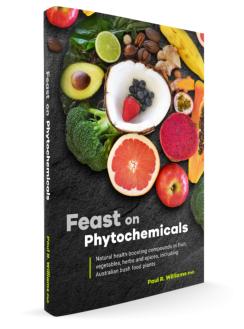Helpful Resources
Below you’ll find a range of sources of information about the phytochemicals found in various fruit, vegetables herbs and spices this website and book are based on.
Links
- Australian Dietary Guidelines – https://www.eatforhealth.gov.au/guidelines
- Dr David Wilkinson’s Food Against Cancer – https://foodagainstcancer.com/
- Dr Duke’s Phytochemical and Ethnobotanical Databases – https://phytochem.nal.usda.gov/phytochem/search/list
- Dr Richard Béliveau’s Research to Prevent Cancer – https://www.richardbeliveau.org/en/
- Nutrition Australia – http://www.nutritionaustralia.org/
- Phenol Explorer – http://phenol-explorer.eu/foods
- Phytochemicals Info – http://www.phytochemicals.info/
- Phytochemicals Information Center – https://pbhfoundation.org/about/res/pic/ref/#allium
- Phytohub – http://phytohub.eu/search/foods
- Susanna Lyle’s Grow Healthy – http://www.growhealthy.net/
- The Linus Pauling Institute’s Micronutrient Information Center – https://lpi.oregonstate.edu/book/export/html/52
References
- Avoseh, O., Oyedeji, O., Rungqu, P., Nkeh-Chungag, B., & Oyedeji, A. (2015). Cymbopogon species; ethnopharmacology, phytochemistry and the pharmacological importance. Molecules, 20(5), 7438-7453.
- Bevege, L. (2004). Centella asiatica: a review. Australian Journal of Medical Herbalism, 16(1), 15.
- Bovier, E. R., & Hammond, B. R. (2015). A randomized placebo-controlled study on the effects of lutein and zeaxanthin on visual processing speed in young healthy subjects. Archives of biochemistry and biophysics, 572, 54-57.
- Bowen-Forbes, C. S., Zhang, Y., & Nair, M. G. (2010). Anthocyanin content, antioxidant, anti-inflammatory and anticancer properties of blackberry and raspberry fruits. Journal of food composition and analysis, 23(6), 554-560.
- Bylka, W., Znajdek‐Awiżeń, P., Studzińska‐Sroka, E., Dańczak‐Pazdrowska, A., & Brzezińska, M. (2014). Centella asiatica in dermatology: an overview. Phytotherapy research, 28(8), 1117-1124.
- Castleman, M. (2017). The New Healing Herbs: The Essential Guide to More Than 130 of Nature’s Most Potent Herbal Remedies. Rodale.
- Cherikoff V. (2015). Wild Foods. Looking back 60,years for clues to our future survival. New Holland Publishers, London.
- Costello, G., Gregory, M. and Donatiu, P. (2009). Southern Macadamia Species Recovery Plan. Report to Department of the Environment, Water, Heritage and the Arts, Canberra by Horticulture Australia Limited, Sydney.
- Cribb A. B. and Cribb J. W. (1988). ‘Wild Medicine in Australia.’ Angus and Roberts North Ryde, Sydney.
- Duester, K. C. (2001). Avocado fruit is a rich source of beta-sitosterol. Journal of the American Dietetic Association, 101(4), 404-405.
- Garg, M. L., Blake, R. J., Wills, R. B., & Clayton, E. H. (2007). Macadamia nut consumption modulates favourably risk factors for coronary artery disease in hypercholesterolemic subjects. Lipids, 42(6), 583-587.
- Gray, N. E., Harris, C. J., Quinn, J. F., & Soumyanath, A. (2016). Centella asiatica modulates antioxidant and mitochondrial pathways and improves cognitive function in mice. Journal of ethnopharmacology, 180, 78-86.
- Grice, I. D., Rogers, K. L., & Griffiths, L. R. (2011). Isolation of bioactive compounds that relate to the anti-platelet activity of Cymbopogon ambiguus. Evidence-Based Complementary and Alternative Medicine, 2011.
- Hegarty, M. P., Hegarty, E. E., & Wills, R. B. H. (2001). Rural industries research and development corporation.
- Jiang, J. Z., Ye, J., Jin, G. Y., Piao, H. M., Cui, H., Zheng, M. Y., … & Yan, G. H. (2017). Asiaticoside Mitigates the Allergic Inflammation by Abrogating the Degranulation of Mast Cells. Journal of agricultural and food chemistry, 65(37), 8128-8135.
- Kim, H., Youn, K., Yun, E. Y., Hwang, J. S., Jeong, W. S., Ho, C. T., & Jun, M. (2015). Oleic acid ameliorates Aβ-induced inflammation by downregulation of COX-2 and iNOS via NFκB signaling pathway. Journal of Functional Foods, 14, 1-11.
- Konczak, I., Sakulnarmrat, K. and Bull, M. (2012) Potential Physiological Activities of Selected Australian Herbs and Fruits. Publication No. 11/097. Rural Industries Research and Development Corporation. Barton, ACT, Australia.
- McKenzie, R. (2012). Australia’s poisonous plants, fungi and cyanobacteria: a guide to species of medical and veterinary importance. CSIRO.
- Müller, V., Lankes, C., Zimmermann, B. F., Noga, G., & Hunsche, M. (2013). Centelloside accumulation in leaves of Centella asiatica is determined by resource partitioning between primary and secondary metabolism while influenced by supply levels of either nitrogen, phosphorus or potassium. Journal of plant physiology, 170(13), 1165-1175.
- Munro, I. A., & Garg, M. L. (2008). 15 Nutrient Composition and Health Beneficial Effects of Macadamia Nuts. In: Tree nuts: Composition, phytochemicals, and health effects, page 249.
- Netzel, M., Netzel, G., Tian, Q., Schwartz, S., & Konczak, I. (2007). Native Australian fruits—a novel source of antioxidants for food. Innovative food science & emerging technologies, 8(3), 339-346.
- Orhan, I. E. (2012). Centella asiatica (L.) Urban: from traditional medicine to modern medicine with neuroprotective potential. Evidence-based complementary and alternative medicine, 2012.
- Paocharoen, V. (2010). The efficacy and side effects of oral Centella asiatica extract for wound healing promotion in diabetic wound patients. J Med Assoc Thai, 93(Suppl 7), S166-S170.
- Pascoe, B. (2014). Dark Emu Black Seeds: Agriculture Or Accident?. Magabala Books.
- Sakulnarmrat, K., Srzednicki, G., & Konczak, I. (2015). Bioprospecting Davidson’s plum and quandong: Cytoprotective and proapoptotic activities. LWT-Food Science and Technology, 61(2), 622-629.
- Wattanathorn, J., Mator, L., Muchimapura, S., Tongun, T., Pasuriwong, O., Piyawatkul, N., … & Singkhoraard, J. (2008). Positive modulation of cognition and mood in the healthy elderly volunteer following the administration of Centella asiatica. Journal of ethnopharmacology, 116(2), 325-332.
- Williams, C. J. (2013). Medicinal plants in Australia Volume 4: An Antipodean Apothecary. Rosenberg Publishing.
- Woodward, P. (2014). Grow your own herbal remedies. Hyland House Publishing, Mebourne.
- Wurm, P. A. S., Campbell, L. C., Batten, G. D., & Bellairs, S. M. (2012). Australian native rice: a new sustainable wild food enterprise. Rural Industries Research and Development Corporation (RIRDC): Barton, Australia.
- Zainol, M. K., Abd-Hamid, A., Yusof, S., & Muse, R. (2003). Antioxidative activity and total phenolic compounds of leaf, root and petiole of four accessions of Centella asiatica (L.) Urban. Food Chemistry, 81(4), 575-581.
Buy the Book
$30.00 + P&H
This book brings the science of plant compounds to people interested in healthy eating and nutrition. It interprets the latest scientific research about health promoting phytochemicals that are supplied to us in common fruit and vegetables (including nuts, legumes and whole grains), herbs and spice.


